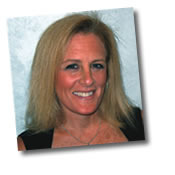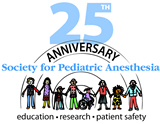- WELCOME
- MEETING INFORMATION
- OBJECTIVES

Welcome to my hometown, Chicago, the Windy City, for the 25th Annual Meeting of the Society of Pediatric Anesthesia.
This year our society turns 25 years old, and our meeting will celebrate this milestone. The meeting will be held at the Hyatt Regency McCormick Place, which is close to many Chicago area attractions – Navy Pier, Buckingham Fountain, Millennium and Grant Parks, fabulous shopping on the “Magnificent Mile” and the renowned Museum Campus that includes the Shedd Aquarium, the Adler Planetarium and the Field Museum. The hotel is also connected via a skybridge to McCormick Place Convention Center.
– Wendy Binstock, MD
Annual Meeting Program Chair
Purpose
The SPA Education Committee has put together an outstanding program, and we have developed new formats based on suggestions from our members who have attended previous meetings. One new feature, “Round Table Discussions” at lunch will be a lively PBLD style session that will include a “pioneer or legend” from the field of pediatric anesthesia at every table. Overall, the program will focus on more interactive sessions with less of an emphasis on the straight lecture style. The theme for this year’s meeting is The Past, Present and Future of Pediatric Anesthesia.
Program Description
The morning session will begin with a brief overview of an exciting project that is currently in the process of documenting the past 25 years of Pediatric Anesthesia: “Pioneers in Pediatric Anesthesia.” This will lead to the first scientific session on the past, present and the future of anesthesia for pediatric transplantation. The second morning session will feature a new format – a live debate on the state of electronic medical records, and finally the morning will conclude with the keynote presentation: “The Future is here: Pharmacogenetics.”
Another format change will occur at the lunch session, which will feature “Round Table Discussions.” Each lunch table will feature a “legend or pioneer” in pediatric anesthesia and a specific topic. Also assigned to each table will be a current leader in the field and a more junior member of our society, who will jointly prepare and present a case for the lunch time discussion. This format affords our members a golden opportunity to learn from the pioneers who have shaped the field of pediatric anesthesia into what it is today, and also from the current and future leaders who will influence the arena of pediatric anesthesia into what it will be for tomorrow and beyond.
Following our lively discussion at the lunch tables, the afternoon session will begin with a panel on “Anesthesia for the Neonate – Then and Now.” Our attendees will get to hear from such legends as George Gregory M.D. on “The Past” when the only options available were Ether, Pancuronium and Oxygen. This will lead to present day research that is focusing on the neurotoxic effects of inhalational agents on the developing brain, and then to the future and new agents on the horizon.
Since anesthesiologists have always been leaders in the field of patient safety and innovators with monitoring techniques, our next session will focus on “Monitoring in Pediatric Anesthesia – Yesterday, Today and Tomorrow.” We will hear from people who were instrumental in the development of pulse oximetry to those who are on the cutting edge of the future of brain monitoring. The final session of this “historic” day will be a panel of legends in our field presenting their favorite story in pediatric anesthesia. These pioneers will enlighten and wow our audience with cases from their careers that influenced their fields of research and the evolution of pediatric anesthesia. This session should provide a wonderful time for a walk down memory lane!
As this meeting marks the beginning of a year-long celebration of the 25th anniversary of the Society for Pediatric Anesthesia, we will end our day with a 25th Anniversary Gala at the Chicago Yacht Club. The Chicago Yacht Club is one of the oldest and most respected yacht clubs in the world. This venue is poised on a spot of land with the beauty of the world-class Chicago skyline on one side, and the majesty of Lake Michigan on the other. The Chicago Yacht Club is adjacent to Chicago’s Loop, and is at the very center of the lakefront cultural, educational, and sporting activities. With views of the skyline, harbor, and Grant Park The Chicago Yacht Club will offer a spectacular setting for our 25th Anniversary Gala. And you won’t want to miss the live entertainment by The Voltage Brothers!
Education Mission Statement
The Annual Meeting will focus on several areas of pediatric anesthesia and healthcare delivery. The overall goals for attendees of this program are to enhance their existing fund of knowledge and introduce them to new state-of-the-art issues that may affect their practice, thereby increasing their ability to provide the highest possible quality of care.
Target Audience
The program is intended for anesthesiologists and other practitioners who care for children in their practice of anesthesiology and/or critical care medicine. It is also intended for clinical and basic science researchers whose areas of investigation relate to pediatric anesthesia/critical care, as well as physicians and healthcare providers interested in learning more about the practice of pediatric anesthesia.
CME Credits
The Society for Pediatric Anesthesia is accredited by the Accreditation Council for Continuing Medical Education to provide continuing medical education for physicians.
The Society for Pediatric Anesthesia designates this live activity for a maximum of 6.5 AMA PRA Category 1 Credit(s)™. Physicians should claim only the credit commensurate with the extent of their participation in the activity.
We look forward to your active participation in the meeting sessions and request that you provide valuable feedback by completing evaluations and comments.
Introduction to the “Pioneers in Pediatric Anesthesia”
Christine Mai, MD
- Articulate the history of Pediatric Anesthesia
- List the key contributors to the field of Pediatric Anesthesia
- Identify the issues and challenges that occured during the formation of the field of Pediatric Anesthesia
Pediatric Transplantation – Where have we been, and where are we going?
Pediatric Cardiac Transplantation - From Vision to Reality
Linda J. Mason, MD
- Understand the history of pediatric cardiac transplantation
- Understand the differences in physiology of a pediatric patient post cardiac transplant
- Learn the implications of immunosuppressive therapy in pediatric patients post transplant as it relates to anesthetic care
Pediatric Pulmonary Transplantation: An Inspiration?
Stuart Hall, MD
- Trace the history of pulmonary transplantation in the pediatric population
- Recognize the specific contributions of pediatric anesthesiology to outcomes in these patients
Liver Transplantation
Peter J. Davis, MD
- Understand the pathophysiology of the surgical procedure of patients undergoing liver transplantation
- Describe the differences in the surgical procedure as it has evolved over time
- Describe the changes in medical/surgical therapy and their impact on patient and graft survival
The Future is Here! DEBATE – Then and Now: The State of Electronic Medical Records
Mohamed A. Rehman, MD
- Understand the anatomy of AIMS (Anesthesia Information Systems)
- Understand the utilization of AIMS data
- Understand the multi-center approach to AIMS data
Marc J. Bloom, MD, PhD
- Understand the reasons why departments continue to use paper records
- Delineate the forces that are driving the replacement of paper records.
- Present reasons why paper records cannot remain the status quo.
Pharmacogenetics: Where Will This Take Us?
Steven Shafer, MD
- Understand the genetic component of atypical responses to anesthetic drugs.
- Understand the types of genetic information that will soon be available on patients presenting for surgery
- Understand how murine pharmacogenomics is opening new doors in understanding human biology
Panel on Anesthesia for the Neonate – Yesterday, Today and Tomorrow: Paralysis to Toxicity
The Past: Ether, Pancuronium and Oxygen
George Gregory, MD
- Understand the basis of modern anesthesia
- Recall how care then transitioned to present day care
- Discuss the history of some anesthetic drugs and anesthesia care.
The Present: Inhalational - Neurotoxicity
Sol Soriano, MD
- Understand the sentinel laboratory reports that are the basis of anesthetic-induced developmental neurotoxicity
- Determine if the laboratory findings can be extrapolated to the care of pediatric patients.
The Present: Opioids
Myron Yaster MD
- Understand the neurobiology and neurophysiology of pain in the newborn
- Understand the use of opioids, local anesthetics, and vapors alone in combination in newborn anesthesia
The Future: Safe and Effective Alternatives for Sedation and General Anesthesia in Neonates
Mervyn Maze, MB, ChB
- Understand mechanism and uses for sedative properties of dexmedetomidine
- Understand mechanism and uses for xenon anesthesia
Monitoring in Pediatric Anesthesia – Then and Now
The Pulse Oximetry Revolution
Randall Wetzel, MD
- Understand the intellectual processes that lead to the widespread application of pulse oximetry
NIRS and Venous-side Monitoring of the Circulation
George Hoffman, MD
- Understand the rationale
- Understand the technology
- Gain a framework for understanding application of current and future technology
Panel of the Pioneers - My Favorite Story
Christine Mai, MD
- Understand of the history of pediatric anesthesia from the stand-point of some of the pioneers who contributed to the creation of the field
- List some of the key contributors to the formation of the field of Pediatric Anesthesia
- Identify the issues and challenges that occured during the creation of the subspecialty


